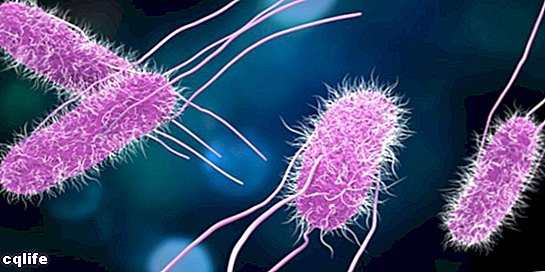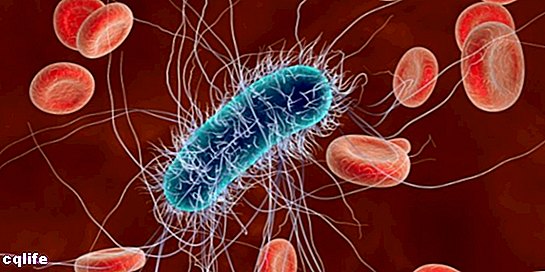- What are Bacteria
- Types of bacteria
- Structure of bacteria
- Examples of bacteria
- Differences between viruses and bacteria
We explain what bacteria are, the types that exist and what their structure is like. Also, some examples and their differences with the virus.

What are Bacteria
Bacteria are a large group of microorganisms prokaryotes (devoid of a membrane that delimits the cell nucleus) of various possible shapes and sizes. Although formerly the term "bacteria" grouped all prokaryotic organisms, today the taxonomy It divides them into two categories: the Bacteria domain and the Archaea domain. Both are grouped in the superkingdom or empire Prokaryota, formed by all prokaryotic organisms, which constitute the living creatures most primitive and most abundant of the planet Earth, adapted to practically all conditions and habitats. Some bacteria can even survive in harsh conditions, such as outer space.
Modern prokaryotes, among which are all bacteria, are immediate descendants of the first unicellular life forms on the planet, which arose in conditions very different from those of today about 4,000 million years ago.
Bacteria have been involved, perhaps due to their abundance, in most jumps evolutionary cell phones. For example, it is believed that, through endosymbiosis processes, they influenced the origin of the mitochondria (organelles present in all eukaryotic cells) or chloroplasts (organelles unique to algae and vegetables cells).
These living beings have relationships with practically all forms of life on the planet, either through relationships of commensalism (such as bacteria that proliferate on the skin), mutualism (such as those that collaborate with the digestion of food in the intestine) or parasitism (as the cause of infections and diseases).
Bacterial life is essential in the decomposition processes of the organic material, necessary for the recycling elements such as carbon or nitrogen, and constitute the basis of the Trophic chains of different environments.
Bacteria reproduce rapidly and through asexual procedures, which consist of the replication of the cell parent in two exactly equal to her (Binary fission). It is estimated that, in a conducive environment, a bacterium is capable of dividing in as little as 15-20 or 20-30 minutes, depending on the species.
Types of bacteria

Bacteria are studied by bacteriology, a branch of the microbiology. Is discipline has classified them according to various criteria:
- According to its morphology:
- Bacilli Elongated in shape, like microscopic rods. Bacilli can also be found in groups of two or in filaments.
- Coconuts Spherical or round shapes. Coconut-like bacteria can also occur in pairs (diplococci), in groups of four (tetracocci), in chains (streptococci), and in irregular clusters or clusters (staphylococci).
- Helical shapes. They can be: vibrios, comma-shaped and slightly curved; spirals, rigid helical or corkscrew in shape; or spirochetes, in the form of a flexible corkscrew.
It is common among bacteria of the same species that they adopt different morphological types, which is called “pleomorphism”.
- According to the composition of its cell wall:
- Gram positive bacteria. They acquire a color purplish or bluish when the crystal violet dye is used, due to the presence of a thickened cell wall.
- Gram negative bacteria. They take on a pinkish or red color when the crystal violet dye is used, due to the presence of a thin cell wall.
- According to its nutrition:
- Photoautotrophic bacteria. They use the sunlight as a source of energy and inorganic substances (mainly CO2) as a source of carbon.
- Chemoautotrophic bacteria. They use inorganic compounds reduced as a source of energy and carbon dioxide as a carbon source.
- Photoheterotrophic bacteria. They use light as a source of energy and organic molecules as a source of carbon.
- Chemoheterotrophic bacteria. They use organic molecules as a source of carbon, which they also use as a reagent in reactions to obtain energy.
There are other classifications of bacteria, which take into account the habitat or its biochemical components.
Structure of bacteria

The single-celled bacterial structure is usually quite simple. Bacteria are made up of a single cell without a membrane that delimits the cell nucleus and almost no defined organelles, but with a nucleoid (irregular region where the DNA circular of prokaryotes) and a peptidoglycan cell wall that lines the cell outside the plasma membrane. In addition, they frequently possess pili (structures involved in the exchange of genetic material between bacteria) or flagella to move (in the case that they are mobile). Some bacteria also have capsules, a rigid protective structure found outside the cell wall.
Scattered in the cytoplasm bacterial are the ribosomes (in which the synthesis of protein) and there are also usually plasmids (small non-chromosomal DNA molecules) and small vacuoles (which function as reservoirs for reserve substances). Some bacteria have prokaryotic compartments, primitive organelles surrounded by folds of the plasma membrane towards the cytoplasm, destined for specific biochemical tasks within the cell, depending on their metabolism.
Examples of bacteria

Bacteria are the most abundant organisms on the planet and are extremely diverse. Throughout evolution they have managed to adapt to all kinds of environments and that is why they are found in all terrestrial and aquatic habitats, even in the most extreme ones, such as acidic springs and the deep ocean.
It is very common to think of bacteria as pathogenic organisms capable of causing infectious diseases. While some of them are harmful, there are many others that are harmless or even beneficial. For example:
- Escherichia coli. It is a gram negative bacterium common in the gastrointestinal tracts of the human being and others animals warm-blooded. Some strains of this bacterium are capable, at certain times, of causing an infection.
- Neisseria gonorrhoeae. It is a gonococcus that causes gonorrhea, a sexually transmitted infection in humans.
- Bacillus anthracis. It is an immobile, gram-positive bacterium that produces recognizable black lesions on the skin (carbuncles).
- Sorangium cellulosum. It is an extremely common gram negative myxobacterium in soils and harmless metabolism.
- Clostridium botulinum. It is a causative agent of botulism. This bacterium secretes a neurotoxin whose growth is known in canning (inflated cans that release gas when opened are a clear symptom) and other canned foods.
- Lactobacillus acidophilus. It is a lactic acid bacterium, mutualistic inhabitant of the human intestine and other mammals. As a result of its own metabolism, this bacterium provides different benefits as it aids in digestion, increases the bioavailability of nutrients and helps keep the digestive tract free of pathogenic microorganisms.
- Lactobacillus acidophilus. It is a genus of bacteria that are symbiotic residents of the human digestive tract. Contributes to the production of vitamin K, vitamin B12, folate and biotin.
Differences between viruses and bacteria
Although they are the best known and most frequent forms of infectiousness for humans, viruses and bacteria are vastly different.
The main difference has to do with your structure and size: while bacteria are single-celled organisms whose size ranges from 0.5 to 5 micrometers in length, Viruses are much simpler and elemental acellular beings, incapable of reproducing except by infecting other cells that function as viral replica factories, after being inoculated with the invading viral DNA.
At present, the scientific community does not quite agree on whether viruses are really alive, because of how primitive their existence is, which is not much more than a DNA molecule or RNA wrapped in a layer of protein. For this reason antibiotics do not work on viruses but on bacteria; while antivirals and antiretrovirals are exclusively used to fight virus infections.
